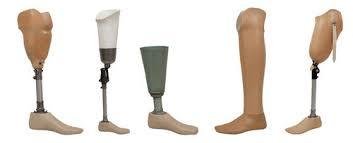Artificial Limbs Meaning
Artificial limbs are custom-made prosthetic devices designed to replace a missing arm, leg, hand, or foot. They are used to correct movement, make appearance better, and rebuild quality of life.Whether you visit an artificial limbs clinic, a brace centre, or an artificial limbs provider, The purpose is identical; to assist people to be mobile and independent again. Modern artificial limbs technology blends engineering, medical science, and advanced materials to make prosthetics more comfortable, functional, and natural-looking than ever before.
Types of Artificial Limbs
Artificial limbs can be classified in different ways:
1. Based on the Limb Replaced
Upper Limb Prostheses
These devices replace all or part of the arm, hand, or fingers.
- Transradial prostheses – Replace the limb below the elbow for natural hand and wrist motion.
- Transhumeral prostheses – Replace the afflicted part above the elbow with an artificial elbow joint.
- Shoulder disarticulation prostheses – Replace the entire arm and shoulder joint.
- Partial hand prostheses – Replace missing fingers or part of the hand.
Lower Limb Prostheses
These replace all or part of a leg, foot, or toes.
- Transtibial prostheses – Replace the limb below the knee, keeping the natural knee joint for easier walking.
- Transfemoral prostheses – Replace the limb above the knee with an artificial knee joint.
- Foot prostheses – Replace a missing foot, sometimes with an ankle joint for varied terrain.
- Hip disarticulation prostheses – Any limb of the hip joint can be replaced by a prosthetic hip joint.
Based on Functional Capabilities
- Passive prostheses – Focus on appearance and basic support.
- Active prostheses – Provide movement and function.
- Body-powered prostheses – Controlled by cables and harnesses connected to body movements.
- Myoelectric prostheses – Use muscle signals to control movements through sensors.
- Hybrid prostheses – Achieve flexible control by combining body-powered and myoelectric.
Based on Activity Level or Purpose
- Activity-specific prostheses – Designed for tasks like swimming, carpentry, or gardening.
- Sport-specific prostheses – Running blades, cycling legs, or skiing prosthetics for athletes.
Advancements in Artificial Limbs Technology
Modern artificial limbs equipment and designs have evolved with:
- Microprocessor-controlled joints – Adjust in real time for smoother walking and stability.
- 3D printing – Creates lightweight, custom-fitted prosthetics faster and more affordably.
- Bionic and robotic prostheses – Offer AI-driven adaptive movements and advanced control.
- Neural interfaces (TMR, TSR, Osseointegration) – Allow direct nerve control and even sensory feedback.
These breakthroughs mean that an artificial limbs & brace centre can now provide solutions that are more natural, durable, and functional than ever before.
Who Needs Artificial Limbs & How They’re Used
Artificial limbs are used by people who have lost a limb due to:
- Accidents or trauma
- Diabetes or vascular diseases
- Cancer or tumors
- Congenital conditions
They help with daily activities such as walking, writing, cooking, or sports, depending on the design. An experienced artificial limbs provider works with each patient to ensure the right fit and training.
What You Should Know Before Getting a Prosthetic or Artificial Limbs
Before visiting an artificial limbs clinic, consider:
- Type of limb replacement needed
- Your daily activity level
- Budget and insurance coverage
- Maintenance requirements
- Training and adaptation time
Prosthetic vs Artificial Limb – Is There a Difference?
The terms are often used interchangeably.
- Prosthetic – Refers to any artificial device that replaces a missing body part.
- Artificial limb – A type of prosthetic specifically for arms, legs, hands, or feet.
Challenges Faced by Artificial Limb Users
- Initial discomfort or skin irritation
- Maintenance and repair costs
- Learning curve for movement and control
- Limited performance in extreme conditions (water, cold, or heavy labor)
Living With Prosthetics – Tips for Success
- Work with your prosthetist for regular adjustments.
- Practice daily to improve comfort and efficiency.
- Maintain hygiene to prevent skin issues.
- Use accessories like liners or sleeves for better fit and cushioning.
- Stay active to build muscle strength and balance.
Conclusion
Artificial limbs are more than medical devices—they are life-changing tools that restore independence and mobility. With the help of modern artificial limbs technology, expert artificial limbs providers, and specialized artificial limbs equipment, users can live fuller, more active lives.

 Download Catalogue
Download Catalogue


